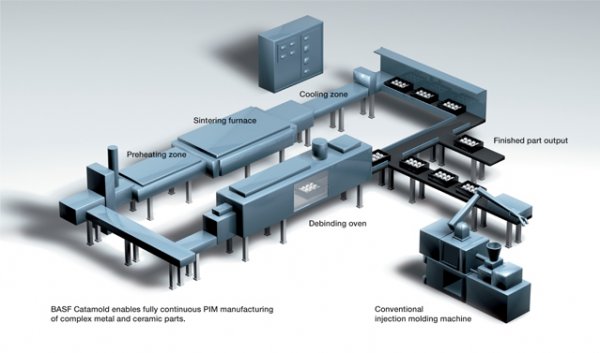Catamold® – Powder Injection Molding made by BASF
![]() Download original article as a PDF
Download original article as a PDF
BASF has an unique background in plastics technology, metal powder production and new materials research. Thanks to this experience, BASF has become a solution provider for powder injection moulding (PIM), making substantial contributions to this innovative manufacturing technology.
Powder injection moulding (PIM) allows moulding metals with same ease and design freedom as for plastics. It has found application across many industry sectors including the automotive field for turbocharger, valve train, gearbox, seat-adjustment, fuel injection and sensor systems parts.
BASF’s revolutionary catalytic debinding technology can be implemented as a fully continuous process. This provides the link between the highly automated moulding machines as used for plastic and the large throughput continuous sintering furnaces as known in powder metallurgy. For this reason BASF PIM technology is naturally suited to the mass production requirements of automotive applications.
BASF aims to be the preferred partner for the automotive industry when it comes to investigate and implement applications of PIM for the manufacturing of car parts.
Product and services
BASF offers a comprehensive product line for powder injection moulding, marketed under the trade name of Catamold®. These products are sold to many customers worldwide, all operating according to the same technology.
BASF’s customers mould Catamold® ready-to-use feedstock – a selected blend of fine metal or ceramic powders and a polyacetal-based plastic binder – in conventional injection moulding machines. The further processing consists of the removal of the plastic binder, according to the revolutionary principles of catalytic debinding and the sintering of the powder compact to achieve very high densities.
The catalytic process allows debinding times up to 10 times faster than conventional technology, combining also high accuracy, excellent composition and dimensional control after sintering.
Catamold® is available in numerous grades ranging from low-alloy steels to stainless steels, from soft magnetic alloys to tool steels, from Ni-superalloys to titanium, from tungsten to ceramics.
Catamold® is however much more than a feedstock: it is an all-round technical package. BASF offers its customers and end-users support in material selection, consulting for part and mould design, feasibility studies, simulation of the moulding process, pilot runs, assistance during start-up and regular production and training.
Research and development
BASF’s extensive know-how in plastics, powder technology and materials allows tackling the challenges of the market, which constantly requests the development of new alloys for new emerging applications.
BASF puts its expertise at the service of its customers and end-users in its best-in-class moulding, debinding, sintering and analytical facilities of the Catamold® Application Technology Department, located next to the feedstock production plant in Lugwigshafen. In these premises BASF leads multiple projects related to new materials, feedstock development and mould design in close cooperation with its customers.
Quality standards
Every single production lot of BASF Catamold® is subjected to a severe validation process, consisting of moulding, debinding and sintering of test parts according to the same process that BASF’s customers run. This ensures long-term consistency and the conformance to product specifications (e.g. flowability, final density and dimensional tolerance after sintering).
BASF Catamold® development, production, quality control and marketing are certified according to DIN EN ISO9001, ISO TS16949, ISO 14001.
BASF SE
GBU Carbonyl Iron Powder and Metal Systems
Powder Injection Molding, G-CA/MI – J513
67056 Ludwigshafen, Germany
Tel: +49 621 60 52835 Fax +49 621 60 22198
Email: [email protected]
Visit the BASF Catamold website







